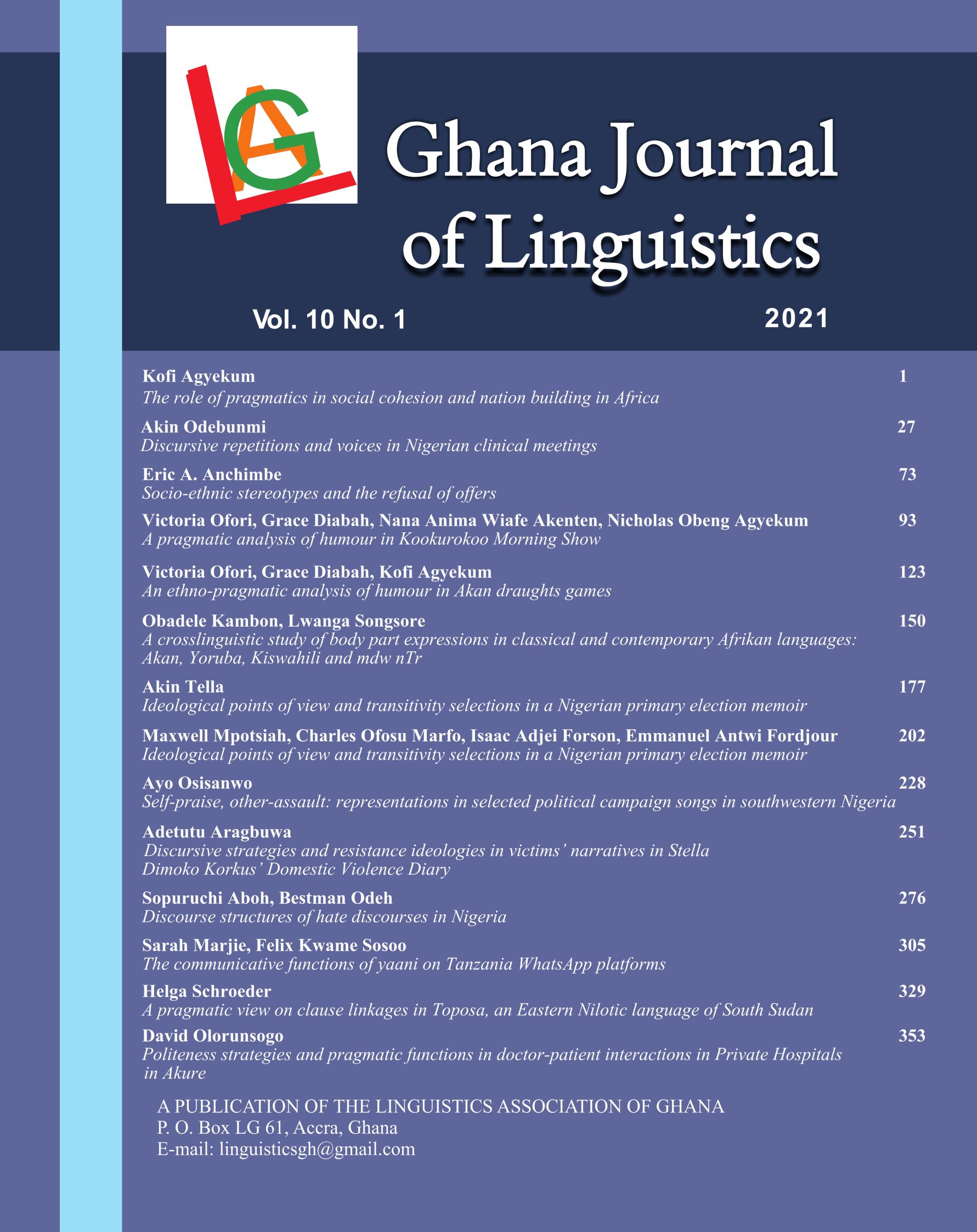A pragmatic view on clause linkages in Toposa, an Eastern Nilotic language of South Sudan
DOI:
https://doi.org/10.4314/gjl.v10i1.317Keywords:
conceptual meaning, procedural meaning, clause-chaining model, foreground-background information, pragmatic routine, constraints on inferenceAbstract
Toposa, an Eastern Nilotic language of South Sudan, has been identified as a clause-chaining language (Schröder 2013, Schröder 2020), because it does not allow two independent clauses following each other, but the fundamental sentence structure is that an independent clause is followed by a chained clause. The current paper claims that this clause-chaining constraint creates new syntactic and semantic functions of independent and subordinative clauses, whereby one syntactic function is clause-skipping that caters for adverbial clauses in the model. The structure of independent clause and chained clause yields semantically a distinction of foreground and background information. The foreground information is carried by the finite and the background information by the non-finite clauses. The interpretation of the foreground and background information is explained as cognitive pragmatic routines that guide the hearer to understand the foreground information as main events and the background information as explanations to the foreground information. The background information captured in the adverbial clauses provide explanations for time, reason-result, means-result, purpose, conditions and contrast. The pragmatic analysis is based on the insights of Relevance theory (Sperber and Wilson 1995).
References
Blakemore, Diane. 1987. Semantic Constraints on Relevance. Oxford: Blackwell.
Foley, William, A. 2010. “Clause Linkage and Nexus in Papuan languages. In Clause Linking and Clause Hierarchy: Syntax and Pragmatics, edited by I. Bril, 50-75. Amsterdam: John Benjamins.
Grimes. Joseph. E. 1975. The Thread of Discourse. The Hague & Paris: Mouton.
Hall, Alison. 2007. “Do Discourse Connectives encode Concepts or Procedures?” Lingua 117(1): 149–174.
Haspelmath, Martin. 1995. “The Converb as a cross-linguistically valid Category.” In Converbs in Cross-linguistic Perspective edited by M. Haspelmath and E. König, 1-55. Berlin: Mouton de Gruyter.
Haiman, John and Pamela Munro, eds. 1983. Switch-reference and Universal Grammar. Amsterdam: John Benjamins.
Iten, Corinne. 2005. Linguistic Meaning, Truth Conditions and Relevance: The Case of Concessive. Basingstoke: Palgrave-McMillan.
Longacre, Robert E. 1996. The Grammar of Discourse. Topics in Language and Linguistics (2nd edition). New York: Plenum.
Longacre, Robert and Shin Ja Hwang. 2012. Holistic Discourse. Dallas: SIL International Publications.
Myhill, John and Junko Hibiya. 1988. “The discourse function of clause-chaining.” In Clause Combining in Grammar and Discourse edited by J. Haiman & S. A. Thompson, 361-398. Amsterdam: John Benjamins.
Roberts, John R. 1997. “Switch-reference in Papua New Guinea: a Preliminary Survey.” In Papers in Papuan linguistics 3. Pacific Linguistics A, 87 edited by A. Pawley, 101-241. Canberra: Research School of Pacific and Asian Studies, Australian National University.
Schröder, Helga. 2013. “Clause-chaining in Toposa, a Pragmatic Approach.” Lodz Papers in Pragmatics 9(1): 25- 44.
Schröder, Helga. 2020. “The Syntax and Semantics of Clause-Chaining in Toposa.” Studies of African Linguistics 49(1): 60-83.
Schröder, Martin C, 2010. Toposa traditional texts. Nairobi: SIL International. Ms.
Sperber, Dan & Deirdre Wilson, 1995. Relevance. Communication and Cognition (2nd edition). Oxford: Blackwell.
Stirling, Lesley. 1993. Switch-reference and Discourse Representation. Cambridge: Cambridge University Press.
Unger, Christoph, 2011. “Exploring the Borderline between Procedural Encoding and Pragmatic Inference.” In Procedural Meaning: Problems and Perspectives. Current Research in the Semantics/Pragmatic Interfac edited by V. Escandell-Vidal, M. Leonetti and A. Ahern, (25)s103-127. Bingley (UK): Emerald Group Publishing.
Van Valin, Robert D. Jr. and Randy J. LaPolla, 1997. Syntax, Meaning and Function. Cambridge: Cambridge University Press.
Van Valin, Robert D, 2005. Exploring the Syntax-Semantics Interface. Cambridge: Cambridge University Press.
Vega Moreno, Rosa E. 2007. Creativity and Conventions: The Pragmatics of Everyday Figurative Speech. Amsterdam: John Benjamins.
Völlmin, Sascha. Azeb Amha, Christian Rapold, and Silvia Zaugg-Coretti, eds. 2007. Converbs, Medial Verbs, Clause-chaining and Related Issues. Cologne: Rüdiger Köppe Verlag.
Wilson, Deirdre. 2011. “The Conceptual-Procedural Distinction: Past, Present and Future.” In Procedural Meaning: Problems and Perspectives. Current Research in the Semantics/Pragmatic Interface edited by V. Escandell-Vidal, M. Leonetti and A. Ahern. (25) 3–31. Bingley (UK): Emerald Group Publishing.
Wilson, Deirdre and Dan Sperber. 2004. “Relevance Theory.” In Handbook of Pragmatics edited by L. Horn and G. Ward, 607-632. Oxford: Blackwell.
Van Valin, Robert D, 2005. Exploring the Syntax-Semantics Interface. Cambridge: Cambridge University Press.
Vega Moreno, Rosa E. 2007. Creativity and Conventions: The Pragmatics of Everyday Figurative Speech. Amsterdam: John Benjamins.
Völlmin, Sascha. Azeb Amha, Christian Rapold, and Silvia Zaugg-Coretti (eds.). 2007. Converbs, Medial verbs, Clause-chaining and Related Issues. Institut für Afrikansiche Sprachwissenschaften, Cologne: Rüdiger Köppe Verlag.
Wilson, Deirdre. 2011. The Conceptual-Procedural Distinction: Past, Present and Future. In Procedural Meaning: Problems and Perspectives. Current Research in the Semantics/Pragmatic interface, vol. 25, edited by Victoria Escandell-Vidal, Manuel Leonetti and Aoife Ahern, 3–31. Bingley (UK): Emerald Group Publishing.
Wilson, Deirdre and Dan Sperber, 2004. Relevance Theory. In Handbook of Pragmatics edited by Laurence Horn and Gregory Ward, 607-632. Oxford: Blackwell.

Downloads
Published
How to Cite
Issue
Section
License
Copyright (c) 2021 Helga Schröder

This work is licensed under a Creative Commons Attribution 4.0 International License.
The Ghana Journal of Linguistics is published by the Linguistics Association of Ghana, P. O. Box LG 61, Legon, Accra, Ghana.
LAG Email: linguisticsgh@gmail.com. Website: http://www.laghana.org
GJL Email: gjl@laghana.org Website: http://www.laghana.org/gjl
© Linguistics Association of Ghana and individual authors, 2023.
